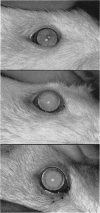Full text
PDF


















































Images in this article
Selected References
These references are in PubMed. This may not be the complete list of references from this article.
- ACHOR W. P., WINKELMANN R. K., PERRY H. O. Cutaneous side effects from use of triparanol (MER-29): preliminary data on ichthyosis and loss of hair. Proc Staff Meet Mayo Clin. 1961 Apr 26;36:217–228. [PubMed] [Google Scholar]
- AVIGAN J., STEINBERG D., THOMPSON M. J., MOSETTIG E. Mechanism of action of MER-29, an inhibitor of cholesterol biosynthesis. Biochem Biophys Res Commun. 1960 Jan;2:63–65. doi: 10.1016/0006-291x(60)90266-7. [DOI] [PubMed] [Google Scholar]
- AVIGAN J., STEINBERG D., THOMPSON M. J., MOSETTIG E. The mechanism of action of MER-29. Prog Cardiovasc Dis. 1960 May;2:525–530. doi: 10.1016/s0033-0620(60)80024-2. [DOI] [PubMed] [Google Scholar]
- AVIGAN J., STEINBERG D., VROMAN H. E., THOMPSON M. J., MOSETTIG E. Studies of cholesterol biosynthesis. I. The identification of desmosterol in serum and tissues of animals and man treated with MER-29. J Biol Chem. 1960 Nov;235:3123–3126. [PubMed] [Google Scholar]
- BECKER B. Accumulation of rubidium-86 by the rabbit lens. Invest Ophthalmol. 1962 Aug;1:502–506. [PubMed] [Google Scholar]
- BECKER B., COTLIER E. Distribution of rubidium-86 accumulated in the rabbit lens. Invest Ophthalmol. 1962 Oct;1:642–645. [PubMed] [Google Scholar]
- BELLOWS J. G. Lens opacities produced by cataractogenic agents, with special reference to triparanol cataract. Am J Ophthalmol. 1963 Mar;55:537–541. [PubMed] [Google Scholar]
- D'ASARO B. S., YOUNG R. G., WILLIAMS H. H. Biochemistry of the eye. III. Lipids of the lens, cornea, iris, ciliary body, and retina. AMA Arch Ophthalmol. 1954 May;51(5):596–598. [PubMed] [Google Scholar]
- FELDMAN G. L., CULP T. W., FELDMAN L. S., GRANTHAM C. K., JONSSON H. T., Jr PHOSPHOLIPIDS OF THE BOVINE, RABBIT, AND HUMAN LENS. Invest Ophthalmol. 1964 Apr;3:194–197. [PubMed] [Google Scholar]
- FELDMAN G. L., FELDMAN L. S. NEW CONCEPTS OF HUMAN LENTICULAR LIPIDS AND THEIR POSSIBLE ROLE IN CATARACTS. Invest Ophthalmol. 1965 Apr;4:162–166. [PubMed] [Google Scholar]
- FRANTZ I. D., Jr, MOBBERLEY M. L., SCHROEPFER G. J., Jr Effects of MER-29 on the intermediary metabolism of cholesterol. Prog Cardiovasc Dis. 1960 May;2:511–518. doi: 10.1016/s0033-0620(60)80021-7. [DOI] [PubMed] [Google Scholar]
- GOULD R. G. Effects of MER-29 on sterol concentration in rat tissues and on cholesterol biosynthesis in vivo and in vitro from mevalonic acid-2-C14. Prog Cardiovasc Dis. 1960 May;2:492–503. doi: 10.1016/s0033-0620(60)80018-7. [DOI] [PubMed] [Google Scholar]
- HARRIS J. E., GRUBER L. The electrolyte and water balance of the lens. Exp Eye Res. 1962 Jun;1:372–384. doi: 10.1016/s0014-4835(62)80027-x. [DOI] [PubMed] [Google Scholar]
- KINOSHITA J. H., MEROLA L. O., DIKMAK E. Osmotic changes in experimental galactose cataracts. Exp Eye Res. 1962 Jun;1:405–410. doi: 10.1016/s0014-4835(62)80030-x. [DOI] [PubMed] [Google Scholar]
- KINSEY V. E., MCLEAN I. W. STUDIES ON THE CRYSTALLINE LENS. 13. KINETICS OF POTASSIUM TRANSPORT. Invest Ophthalmol. 1964 Dec;3:585–591. [PubMed] [Google Scholar]
- KINSEY V. E., REDDY D. V. STUDIES ON THE CRYSTALLINE LENS. XI. THE RELATIVE ROLE OF THE EPITHELIUM AND CAPSULE IN TRANSPORT. Invest Ophthalmol. 1965 Feb;4:104–116. [PubMed] [Google Scholar]
- KIRBY T. J., Jr, ACHOR R. W., PERRY H. O., WINKELMANN R. K. Cataract formation after triparanol therapy. Arch Ophthalmol. 1962 Oct;68:486–489. doi: 10.1001/archopht.1962.00960030490010. [DOI] [PubMed] [Google Scholar]
- KOTTKE B. A., BOLLMAN J. L., JUERGENS J. L. A syndrome of dehydration produced by hypocholesteremic agents. Proc Staff Meet Mayo Clin. 1962 Jan 3;37:1–6. [PubMed] [Google Scholar]
- LAUGHLIN R. C., CAREY T. F. Cataracts in patients treated with triparanol. JAMA. 1962 Jul 28;181:339–340. doi: 10.1001/jama.1962.03050300059020a. [DOI] [PubMed] [Google Scholar]
- NICOLAIDES N., ROTHMAN S. The site of sterol and squalene synthesis in the human skin. J Invest Dermatol. 1955 Feb;24(2):125–129. doi: 10.1038/jid.1955.20. [DOI] [PubMed] [Google Scholar]
- SCANU A., HAWK W. A., PAGE I. H. Lethal effect in dogs of prolonged triparanol oral administration. Arch Pathol. 1962 Jun;73:445–450. [PubMed] [Google Scholar]
- STOKES W. M., HICKEY F. C., FISH W. A. Sterol metabolism. I. The occurrence of desmosterol (24-dehydrocholesterol) in rat skin and its conversion in vivo to cholesterol. J Biol Chem. 1958 May;232(1):347–359. [PubMed] [Google Scholar]
- Steinberg D., Avigan J., Feigelson E. B. EFFECTS OF TRIPARANOL (MER-29) ON CHOLESTEROL BIOSYNTHESIS AND ON BLOOD STEROL LEVELS IN MAN. J Clin Invest. 1961 May;40(5):884–893. doi: 10.1172/JCI104323. [DOI] [PMC free article] [PubMed] [Google Scholar]















